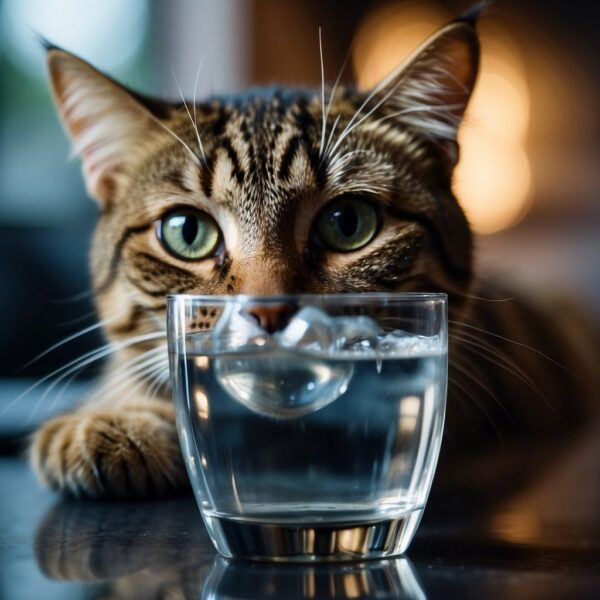
Ice Cubes and Cats. Risks and Benefits
Many cat parents have observed their feline friends’ fascination with ice cubes, often wondering if it’s a safe practice to allow them to play with or consume ice. On the surface, ice cubes may seem like a harmless and even entertaining item for cats, providing both hydration and play. However, it’s important to consider the safety implications of ice cubes for the health and well-being of cats. While there’s no one-size-fits-all answer, understanding the potential risks and benefits associated with ice cubes can guide cat parents in making informed decisions.
Some cats enjoy the cooling sensation of ice, especially during warm weather, which can encourage them to stay hydrated. Additionally, ice cubes can offer a form of dental cleaning and entertainment. Despite these benefits, ice cubes can pose choking hazards or potentially damage a cat’s teeth if bitten into. Hence, it’s advisable to supervise cats when they’re interacting with ice and to provide smaller chunks of ice to minimize risks. By considering factors such as a cat’s health, dietary needs, and individual behavior, parents can safely incorporate ice into their care routine when appropriate.
Are Ice Cubes SAfe For Cats Key Takeaways
- Ice can be both hydrating and entertaining for cats, but supervision is key to ensuring safety.
- Choking hazards and dental damage are potential risks when cats play with or chew on ice cubes.
- It is important to consider the cat’s individual health and behavior when offering ice as part of their care.
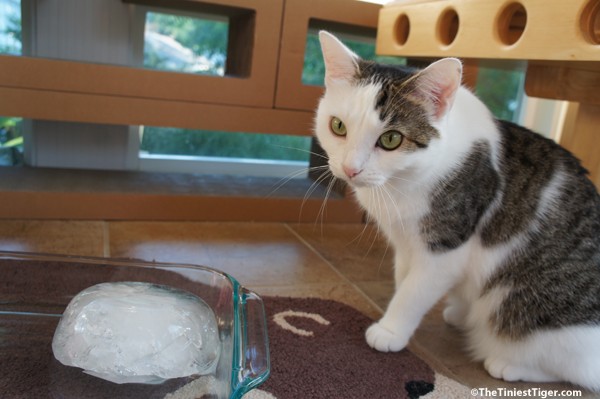
The Physical Impact of Ice on Cats
In the interest of maintaining a cat’s well-being, it’s essential to evaluate how ice can affect their dental health, temperature regulation, and safety in relation to choking.
Dental Considerations
Teeth: Introducing ice cubes to a cat’s environment has implications for dental health. Chewing on hard ice cubes may lead to tooth fractures or other dental problems.
- Chewing hard ice: It can be detrimental to teeth, with the potential to cause cracks or breakage.
- Dental issues: Over time, repeated chewing on ice might contribute to dental problems, although some suggest it can help scrape away food particles.
Temperature Sensitivity
Brain freeze and pain: Cats may experience a form of brain freeze, a sharp pain due to the rapid cooling and rewarming of blood vessels in the roof of the mouth.
- Sensitivity to cold: Cats have varying levels of tolerance to cold. Ingesting ice can lead to discomfort or pain in some cats, displaying a sensitivity to the temperature of the ice.
Choking Risks and Preventive Measures
Choking hazards: Small and slippery objects like ice cubes can become choking hazards for cats.
- Slippery and uncertain size: Ice cubes are slippery and can accidentally be swallowed whole, leading to choking.
Preventive measures: Ensuring cubes are of an appropriate size and supervising play can mitigate risks.
- Ice size: Breaking up ice cubes into smaller, more manageable pieces can prevent them from being a choking hazard.
- Supervision: Always supervise cats when they’re interacting with ice to ensure their safety.
Behavioral and Psychological Effects
Cats may find ice cubes to be fascinating objects that provide mental stimulation and cater to their inquisitive nature. The interaction with ice can bring out behaviors linked to their instinctual hunting patterns, while the distinct sounds and movements of ice cubes appeal to their sensory curiosities.
Stimulation Through Interaction with Ice
Ice cubes can act as a form of entertainment for cats as they swat, chase, and paw at them. The slippery surface of ice creates unpredictable movements, simulating the erratic way prey might act in the wild. This unpredictable movement can trigger a cat’s natural instincts to pounce and play, offering considerable mental stimulation and keeping them engaged. Such interaction is beneficial as it allows cats to exhibit natural behaviors and can prevent boredom.
- Playing with Ice: A cat playing with an ice cube may mimic hunting behaviors.
- Mental Stimulation: Chasing erratic movements of melting ice can keep a cat’s mind active.
Sounds and Movements Attracting Cats
Cats have sensitive hearing and are naturally drawn to the sounds of ice clinking against a bowl or skittering across a floor. These sounds can pique their curiosity and encourage them to explore. The visual appeal of ice cubes shimmering and gliding may also resemble the movement of prey, such as small insects or rodents, sparking their predatory instincts to stalk and capture. As cats interact with ice, they experience a sense of novelty and discovery that can be both calming and captivating for them.
- Attracted to Sound: The sound of ice can lure cats to investigate and engage with it.
- Exploring Instincts: The act of pursuing and batting at ice cubes taps into a cat’s inquisitive nature.
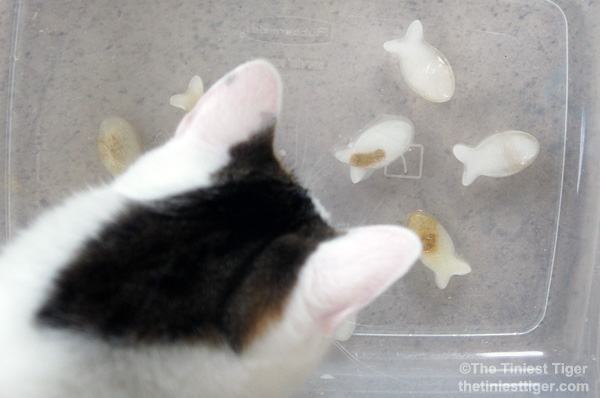
Environmental Factors and Seasonal Considerations
During the warmer months, it’s important to consider the impact of temperature on a cat’s well-being, offering ways to assist them in cooling down and preventing dehydration.
Summertime Cooling and Ice
Cats tend to seek out cool spaces during the summer to regulate their body temperature. Ice can be a quick solution for helping them cool off. By simply adding ice cubes to a cat’s water bowl, parents can encourage their cats to drink more and stay hydrated, which is essential as cats are prone to heat stroke. Another creative approach is providing a “catsicle,” which is a frozen treat that serves both as a cooling aid and a source of hydration. However, it’s important to note that while cats may find relief in these icy solutions, there’s always a risk of choking or dental damage if a cat chews on ice cubes directly.
- Ways to use ice for cooling down cats in the summer:
- Add ice cubes to water bowls
- Create “catsicles” or frozen treats
Alternatives to Ice for Temperature Regulation
Although ice is a useful tool for cooling during hot weather, there are alternative methods to keep a cat comfortable that do not involve the potential risks associated with ice. Cooling mats and cooling bowls are designed to maintain a lower temperature without the hazards of swallowing or chewing ice. For outdoor cats, providing shaded areas and ensuring they have access to cool, indoor spaces can also help. In extreme temperatures, lookout for signs of overheating, such as excessive panting, and consider placing a frozen bottle wrapped in a towel for a cat to lie against.
- Other cooling methods for cats in hot environments:
- Use cooling mats or bowls
- Offer shaded areas or allow access to cooler indoor spots
- Monitor for overheating and provide a wrapped frozen bottle as a cooling surface
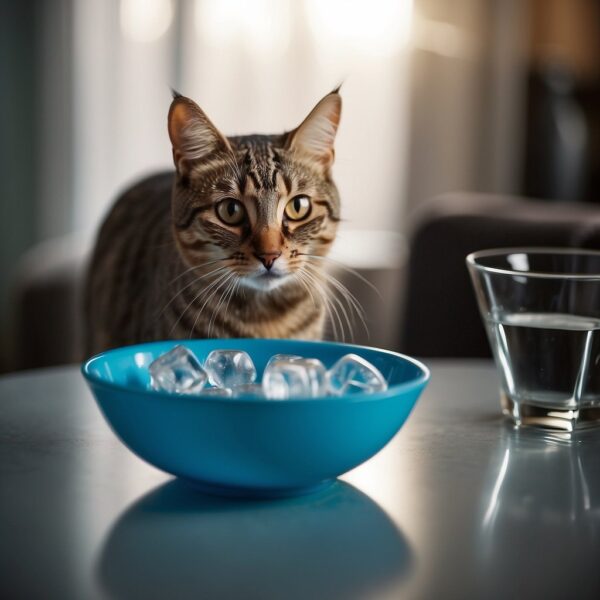
Understanding a Cat’s Dietary Needs
Cats require a diet that supports their hydration and metabolic needs. Adequate water intake is crucial for their overall health and digestion.
Hydration Essentials for Cats
Cats often don’t drink enough water on their own. Water is essential in a cat’s diet as it aids digestion and helps maintain proper kidney function. A cat’s body is made up of about 60-70% water, so staying hydrated is key to their wellbeing. To encourage a cat to drink more water, parents can do the following:
- Provide fresh water daily: Make sure they always have access to clean water.
- Multiple water sources: Place several water bowls around the home.
- Running water: Some cats prefer drinking from a fountain which provides fresh, running water.
- Wet cat food: Incorporate wet food into their diet, which has a higher moisture content.
Nutritional Importance of Water
The water in a cat’s diet contributes significantly to their health by supporting their metabolism and nutrient uptake. Without sufficient water, cats may develop health issues, including urinary problems and reduced metabolic efficiency. Here’s how water integrates into a cat’s nutrition:
- Metabolism: Water is crucial for a healthy metabolism, as it helps process the nutrients from their food.
- Digestion: Adequate water intake ensures proper digestion and nutrient absorption.
- Detoxification: Water helps flush toxins out of the body, promoting better kidney function and overall health.
Ensuring cats have enough water is a simple but vital part of their dietary needs.
Safe Usage of Ice in Cat Care
Introducing ice cubes to cats serves both as a refreshment and a way to keep them hydrated. However, caution is essential to avoid health risks.
Innovative Ways to Introduce Ice
Cat parents can be creative when providing their pets with ice. A straightforward method is adding a couple of ice cubes to the water bowl to keep the water cold. This can be especially refreshing during hot weather. Alternatively, ice cubes can be given as a plaything on a hard, safe floor where the cat can bat the cubes around. This not only cools them down but also encourages physical activity.
For a more engaging experience, some parents may opt to use a cat water fountain, where ice cubes can be placed in the water reservoir. The flowing water from the fountain remains cool and is often more enticing for cats, encouraging hydration.
Precautions to Ensure Safety
Safety is paramount when offering cats ice cubes. Choking hazards can be a concern with smaller kittens, so it is advised to supervise them when interacting with ice. For kittens or smaller cats, consider using crushed ice or small ice chips that are easier to lick and manage.
Another point of concern is the temperature. Extreme cold can be uncomfortable or even harmful to a cat’s mouth and teeth. Thus, letting the ice sit for a bit and slightly melt before giving it to cats is a good practice.
Parents should also be aware of the surfaces on which the ice is provided; slippery floors can lead to accidents. Always ensure that the play area is safe and that ice pieces are too large for a cat to swallow whole, but small enough to prevent dental damage.
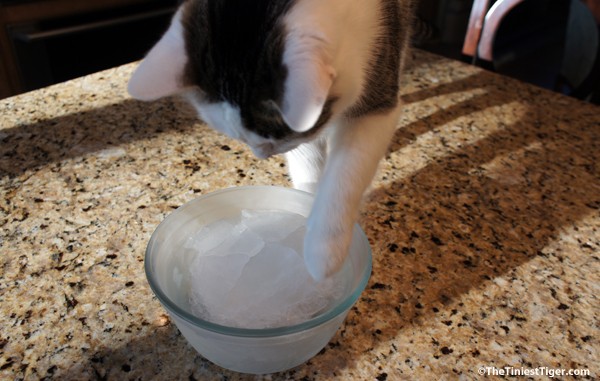
Cats and Ice cubes Frequently Asked Questions
Cats exhibit varied reactions to ice cubes in their water, and while the cold can be refreshing, there are potential risks and benefits. Parents should be aware of their cat’s preferences and any health considerations when introducing ice to their water.
Do cats like having ice cubes in their water?
Some cats enjoy the added stimulation and the coolness ice cubes provide, but this can vary widely from one cat to another. They might be fascinated by the floating ice and interact with it, making hydration more appealing.
Can ice cubes pose a choking risk to cats?
While it is rare, there is a small risk that ice cubes can pose a choking hazard, particularly for small kittens or cats that tend to chew vigorously. It is important to supervise your cat if you decide to introduce ice into their bowl.
Is it safe to put ice cubes in a cat’s water fountain?
Yes, it is generally safe to add ice cubes to a cat’s water fountain, as long as the fountain continues to function properly and the water doesn’t become too cold. This can help keep the water fresh and encourage the cat to drink more.
Could ice cubes help soothe a cat with diarrhea?
If a cat is suffering from diarrhea, providing ice chips can help keep them hydrated, but it is not a treatment for the condition. Always consult with a veterinarian for proper diagnosis and treatment.
Is cold water harmful to cats in any way?
Cold water is not harmful to cats, and some may prefer it, especially in warmer climates or seasons. However, it should not be too cold as extreme temperatures can be a shock to their system.
Are there dental health risks for cats who chew on ice cubes?
Chewing on ice cubes can potentially lead to dental damage for cats, such as cracks or fractures in their teeth. Monitoring a cat’s reaction to ice and providing it in moderation can help to minimize this risk.